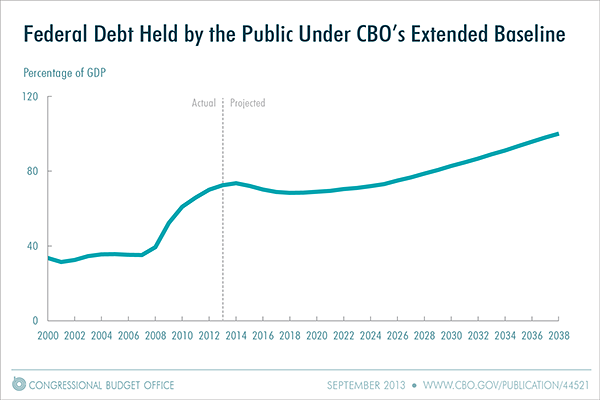CBO: U.S. government recorded largest budget deficits relative to economy size since 1946!
Between 2009 and 2012, the federal government recorded the largest budget deficits relative to the size of the economy since 1946, causing federal debt to soar. Federal debt held by the public is now about 73 percent of the economy’s annual output, or gross domestic product (GDP).
That percentage is higher than at any point in U.S. history except a brief period around World War II, and it is twice the percentage at the end of 2007. If current laws generally remained in place, federal debt held by the public would decline slightly relative to GDP over the next several years, CBO projects. After that, however, growing deficits would ultimately push debt back above its current high level. CBO projects that federal debt held by the public would reach 100 percent of GDP in 2038, 25 years from now, even without accounting for the harmful effects that growing debt would have on the economy (see the figure below). Moreover, debt would be on an upward path relative to the size of the economy, a trend that could not be sustained indefinitely.
Budget Projections for the Next 10 Years
The economy’s gradual recovery from the 2007–2009 recession, the waning budgetary effects of policies enacted in response to the weak economy, and other changes to tax and spending policies have caused the deficit to shrink this year to its smallest size since 2008: roughly 4 percent of GDP, compared with a peak of almost 10 percent in 2009. If current laws governing taxes and spending were generally unchanged—an assumption that underlies CBO’s 10-year baseline budget projections—the deficit would continue to drop over the next few years, falling to 2 percent of GDP by 2015. As a result, by 2018, federal debt held by the public would decline to 68 percent of GDP.
However, budget deficits would gradually rise again under current law, CBO projects, mainly because of increasing interest costs and growing spending for Social Security and the government’s major health care programs (Medicare, Medicaid, the Children’s Health Insurance Program, and subsidies to be provided through health insurance exchanges). CBO expects interest rates to rebound in coming years from their current unusually low levels, sharply raising the government’s cost of borrowing. In addition, the pressures of an aging population, rising health care costs, and an expansion of federal subsidies for health insurance would cause spending for some of the largest federal programs to increase relative to GDP. By 2023, CBO projects, the budget deficit would grow to almost 3½ percent of GDP under current law, and federal debt held by the public would equal 71 percent of GDP and would be on an upward trajectory.
(CBO.GOV)





0 comments :